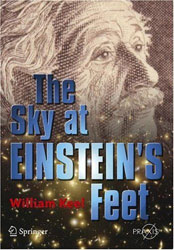
Thought experiments highlight people’s power to perceive that which is not directly in front of their eyes. Light, that capricious, expansive particle-wave, stretches our perception to the roots of time. Yet astronomers can use the nuances of wily, scattering light to whittle an image of the universe, as shown in William Keel’s book The Sky at Einstein’s Feet. In it he shows that though the carving isn’t complete, we are beginning to perceive a substantive structure of stars in the sky.
The tricks of light were being discovered via magnetism and electricity when Einstein formulated his ideas of relativity. With this, our understanding of light stepped far into the unseeable. Further, light’s speed became a standard yardstick, even less controvertible than time. At about the same moment in history, the new equipment of astronomers was adding greater detail to the mapping of the night sky. Alongside stars there were separate galaxies, super clusters, sporadic pulsars, and deep black holes. Each has a distinct signature in the universe and a special basis in the realm of physics. Using their individuality, together with an understanding of the overall physical processes, leads us to a clearer perception of the universe’s extents, even though we inhabit just one small corner.
Keel, in his book, wants to share with a wide audience the impact of relativity on astronomy. To do this, he introduces many of the subtleties of relativity and the way that astronomy either takes advantage or accommodates them. He starts by exploring the influence of relativity. He describes processes such as photoionization that led to astronomical spectroscopy which in itself led to atomic identification through absorption or emission lines. Then there’s the more exotic superluminal motion that appears to display something moving faster than light. More importantly, this can indicate shapes of dust clouds. Applying the Penrose-Terrell rotation effect to the jets of quasars helps explain their appearance. As Keel writes, these are just some of the factors that astronomers need keep in mind when considering the results from night time imaging.
However, even given the book’s title, Keel isn’t purely assessing relativity in astronomy. Rather, he’s acknowledging its import in recent interpretations. For instance, gravitational lensing, which also has a firm basis in relativity, is a valuable tool to gauge distances of very far galaxies as well as masses of interposing galaxies. White dwarfs, the incredible dense objects often found circling other stars, have a huge pressure due to quantum allocations. But their spectroscopic absorption lines tell of a gravitational red shift on top of the Doppler red shift. Keel notes these and other processes and methods used to establish more relevance to the objects of the night. Though he often uses relativity as a link, the book’s contents most point to a desire to share the lore of astronomy.
And as with most technical books on astronomy, there’s a lot of references throughout. Keel includes the names of many prominent researches and many observatories together with their equipment’s particular adaptations. Though at times the reading is styled as if for a research paper, it isn’t dry. Keel includes anecdotes that continually raise the serendipitous nature of research as well as the pitfalls of being at the leading edge. As well, clear, concise explanations introduce most new terms, such as his description of an electron’s motion to explain synchrotron radiation. This, together with descriptive introductions to chapters and a good selection of illustrations make the book a well detailed, enjoyable read for the average amateur astronomer and those interested in the physics behind the pretty pictures of the night sky.
With this book, Keel should achieve his objective of giving a wide audience an understanding of the impact of relativity in astronomy. This works for whether the reader is knowledgeable of relativity and is interested in some applications or the reader is knowledgeable in astronomy and wants to know more about the reason for what they see through the eyepiece. However, for those potential readers who have neither background, this book may be either too detailed or too specialist. Keel doesn’t provide foundations for either of these fields to the likely confusion of the uninitiated. Thus, this book is best as a tool or aid to help blend theory with observation.
A hundred years of using relativity as first introduced by Einstein has given us great rewards. We have a better understanding of the constituents of atoms and how they influence the light from stars. We also know that gravity can effect mass as much as light. William Keel in his book The Sky at Einstein’s Feet gives the reader a change to merge visual images of the night sky with imaginative theory for greater rewards in astronomical viewing.
Review by Mark Mortimer
